Contract Law: Examination of Contract Elements, Terms, and Liability
VerifiedAdded on 2023/04/10
|14
|4107
|54
Report
AI Summary
This report delves into the core aspects of contract law, providing a comprehensive understanding of its various elements and applications. It begins by outlining the essential elements of a valid contract, such as offer, acceptance, consideration, and agreement, and then differentiates between various types of contracts, including unilateral, bilateral, sealed, simple, written, verbal, face-to-face, and distance selling contracts. The report further explores different types of terms within a contract, including implied, express, condition, warranty, innominate terms, and exclusion clauses, supported by case law examples. It then applies these concepts to practical scenarios, analyzing the application of essential elements in a given case and the legal implications of contract terms, specifically exclusion clauses. The report also examines remedies available in cases of breach of contract. Finally, it contrasts tortious and contractual liabilities, exploring the nature of liability in negligence and vicarious liability in business, and applies these elements to tort scenarios. This report aims to provide a clear and concise overview of contract law principles, supported by relevant case law and practical examples.
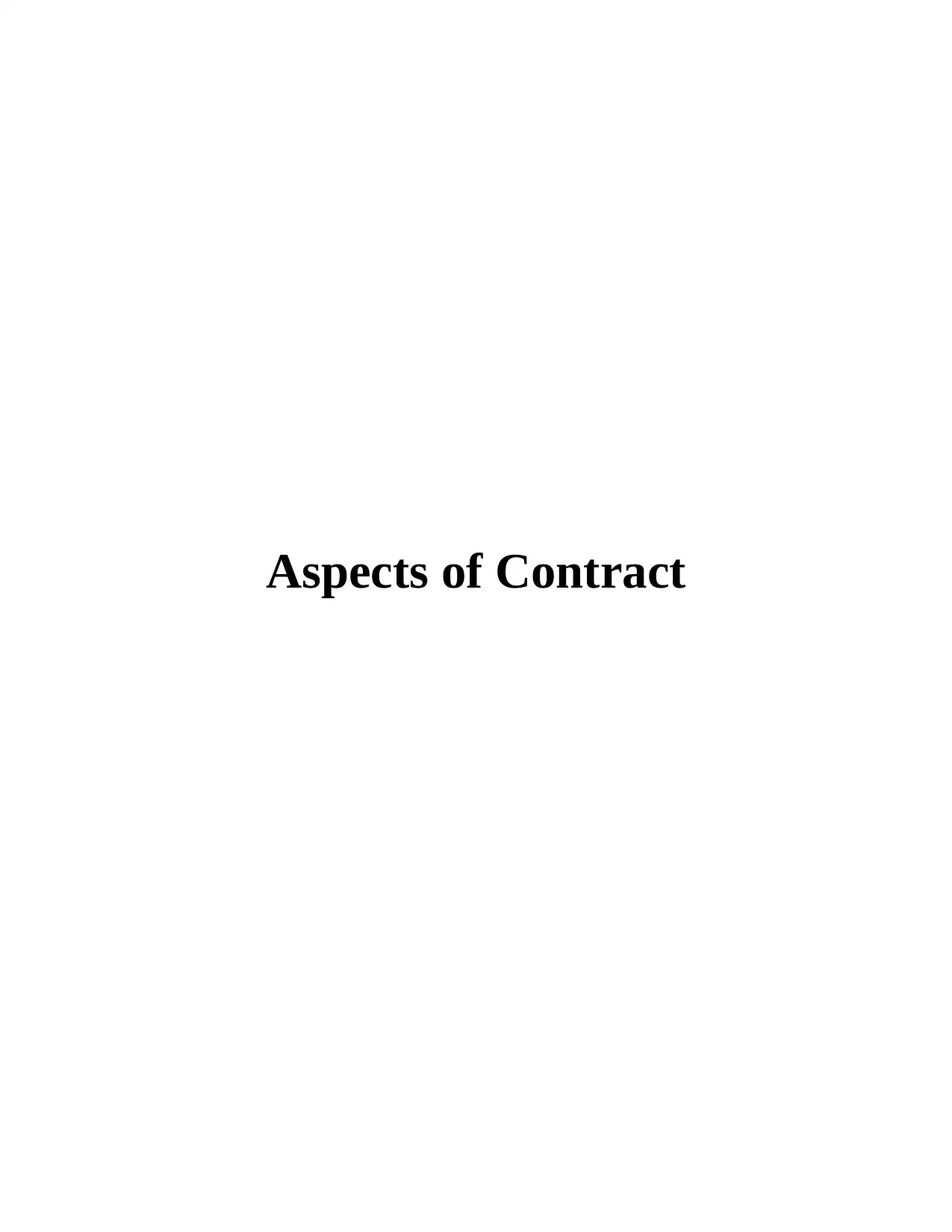
Aspects of Contract
Paraphrase This Document
Need a fresh take? Get an instant paraphrase of this document with our AI Paraphraser
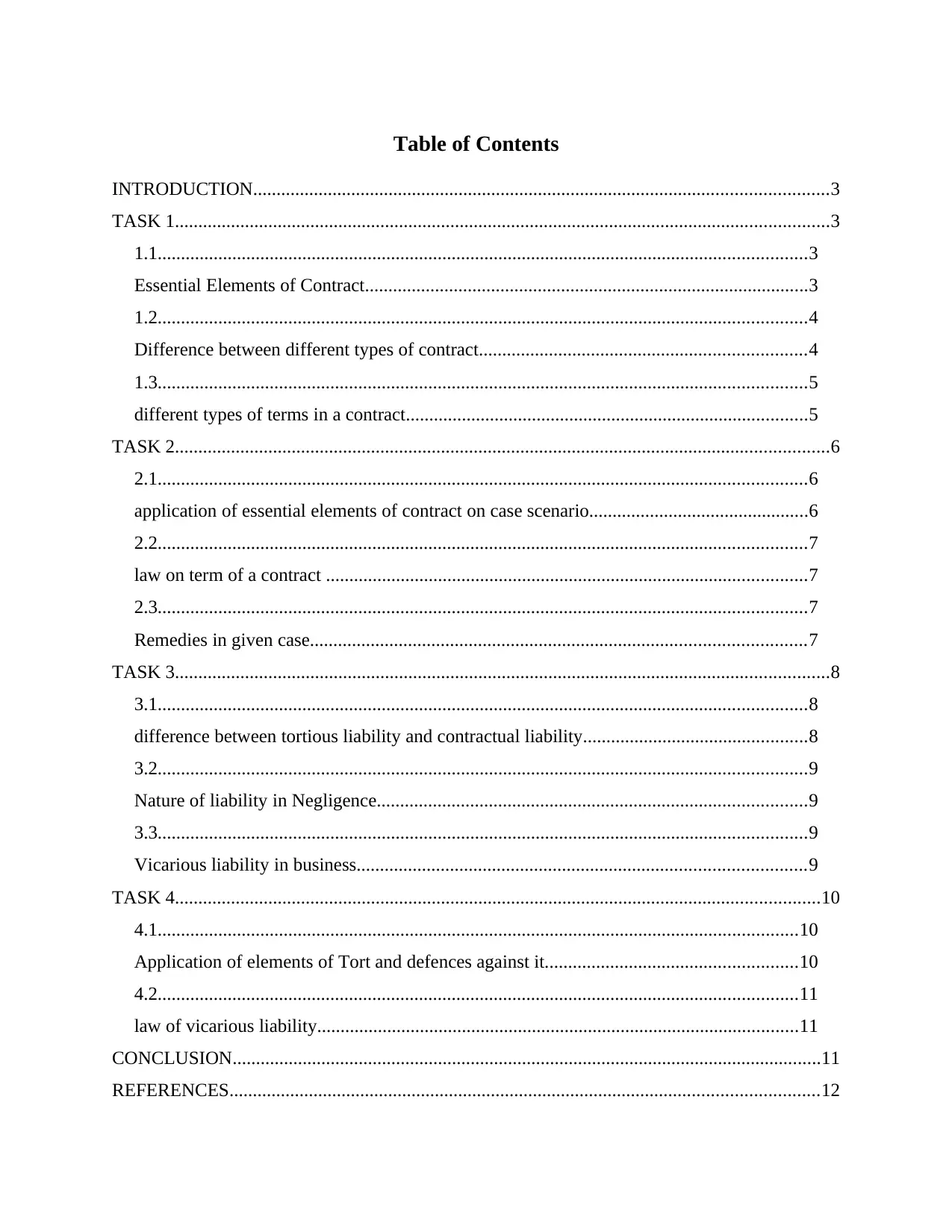
Table of Contents
INTRODUCTION...........................................................................................................................3
TASK 1............................................................................................................................................3
1.1...........................................................................................................................................3
Essential Elements of Contract...............................................................................................3
1.2...........................................................................................................................................4
Difference between different types of contract......................................................................4
1.3...........................................................................................................................................5
different types of terms in a contract......................................................................................5
TASK 2............................................................................................................................................6
2.1...........................................................................................................................................6
application of essential elements of contract on case scenario...............................................6
2.2...........................................................................................................................................7
law on term of a contract .......................................................................................................7
2.3...........................................................................................................................................7
Remedies in given case..........................................................................................................7
TASK 3............................................................................................................................................8
3.1...........................................................................................................................................8
difference between tortious liability and contractual liability................................................8
3.2...........................................................................................................................................9
Nature of liability in Negligence............................................................................................9
3.3...........................................................................................................................................9
Vicarious liability in business................................................................................................9
TASK 4..........................................................................................................................................10
4.1.........................................................................................................................................10
Application of elements of Tort and defences against it......................................................10
4.2.........................................................................................................................................11
law of vicarious liability.......................................................................................................11
CONCLUSION..............................................................................................................................11
REFERENCES..............................................................................................................................12
INTRODUCTION...........................................................................................................................3
TASK 1............................................................................................................................................3
1.1...........................................................................................................................................3
Essential Elements of Contract...............................................................................................3
1.2...........................................................................................................................................4
Difference between different types of contract......................................................................4
1.3...........................................................................................................................................5
different types of terms in a contract......................................................................................5
TASK 2............................................................................................................................................6
2.1...........................................................................................................................................6
application of essential elements of contract on case scenario...............................................6
2.2...........................................................................................................................................7
law on term of a contract .......................................................................................................7
2.3...........................................................................................................................................7
Remedies in given case..........................................................................................................7
TASK 3............................................................................................................................................8
3.1...........................................................................................................................................8
difference between tortious liability and contractual liability................................................8
3.2...........................................................................................................................................9
Nature of liability in Negligence............................................................................................9
3.3...........................................................................................................................................9
Vicarious liability in business................................................................................................9
TASK 4..........................................................................................................................................10
4.1.........................................................................................................................................10
Application of elements of Tort and defences against it......................................................10
4.2.........................................................................................................................................11
law of vicarious liability.......................................................................................................11
CONCLUSION..............................................................................................................................11
REFERENCES..............................................................................................................................12
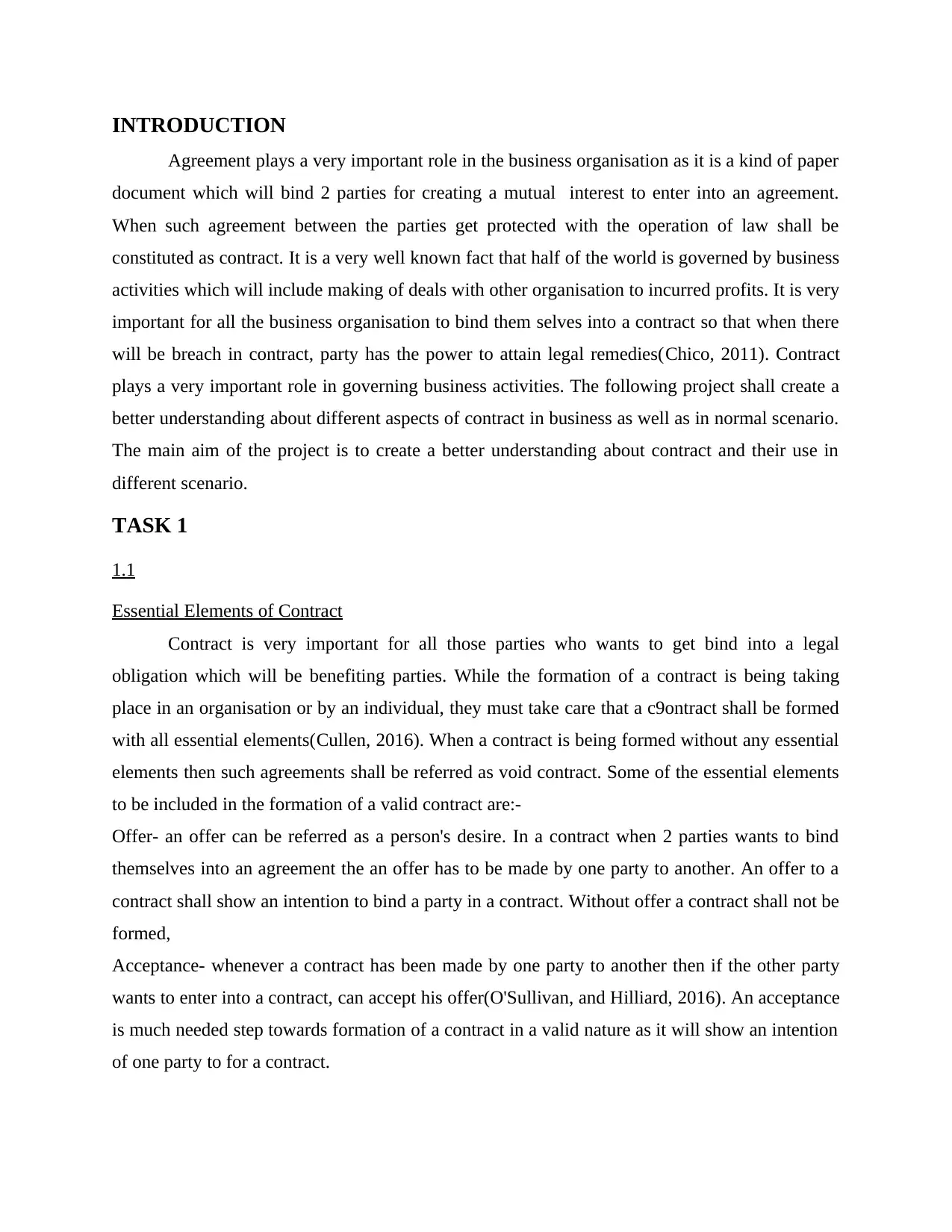
INTRODUCTION
Agreement plays a very important role in the business organisation as it is a kind of paper
document which will bind 2 parties for creating a mutual interest to enter into an agreement.
When such agreement between the parties get protected with the operation of law shall be
constituted as contract. It is a very well known fact that half of the world is governed by business
activities which will include making of deals with other organisation to incurred profits. It is very
important for all the business organisation to bind them selves into a contract so that when there
will be breach in contract, party has the power to attain legal remedies(Chico, 2011). Contract
plays a very important role in governing business activities. The following project shall create a
better understanding about different aspects of contract in business as well as in normal scenario.
The main aim of the project is to create a better understanding about contract and their use in
different scenario.
TASK 1
1.1
Essential Elements of Contract
Contract is very important for all those parties who wants to get bind into a legal
obligation which will be benefiting parties. While the formation of a contract is being taking
place in an organisation or by an individual, they must take care that a c9ontract shall be formed
with all essential elements(Cullen, 2016). When a contract is being formed without any essential
elements then such agreements shall be referred as void contract. Some of the essential elements
to be included in the formation of a valid contract are:-
Offer- an offer can be referred as a person's desire. In a contract when 2 parties wants to bind
themselves into an agreement the an offer has to be made by one party to another. An offer to a
contract shall show an intention to bind a party in a contract. Without offer a contract shall not be
formed,
Acceptance- whenever a contract has been made by one party to another then if the other party
wants to enter into a contract, can accept his offer(O'Sullivan, and Hilliard, 2016). An acceptance
is much needed step towards formation of a contract in a valid nature as it will show an intention
of one party to for a contract.
Agreement plays a very important role in the business organisation as it is a kind of paper
document which will bind 2 parties for creating a mutual interest to enter into an agreement.
When such agreement between the parties get protected with the operation of law shall be
constituted as contract. It is a very well known fact that half of the world is governed by business
activities which will include making of deals with other organisation to incurred profits. It is very
important for all the business organisation to bind them selves into a contract so that when there
will be breach in contract, party has the power to attain legal remedies(Chico, 2011). Contract
plays a very important role in governing business activities. The following project shall create a
better understanding about different aspects of contract in business as well as in normal scenario.
The main aim of the project is to create a better understanding about contract and their use in
different scenario.
TASK 1
1.1
Essential Elements of Contract
Contract is very important for all those parties who wants to get bind into a legal
obligation which will be benefiting parties. While the formation of a contract is being taking
place in an organisation or by an individual, they must take care that a c9ontract shall be formed
with all essential elements(Cullen, 2016). When a contract is being formed without any essential
elements then such agreements shall be referred as void contract. Some of the essential elements
to be included in the formation of a valid contract are:-
Offer- an offer can be referred as a person's desire. In a contract when 2 parties wants to bind
themselves into an agreement the an offer has to be made by one party to another. An offer to a
contract shall show an intention to bind a party in a contract. Without offer a contract shall not be
formed,
Acceptance- whenever a contract has been made by one party to another then if the other party
wants to enter into a contract, can accept his offer(O'Sullivan, and Hilliard, 2016). An acceptance
is much needed step towards formation of a contract in a valid nature as it will show an intention
of one party to for a contract.
⊘ This is a preview!⊘
Do you want full access?
Subscribe today to unlock all pages.

Trusted by 1+ million students worldwide
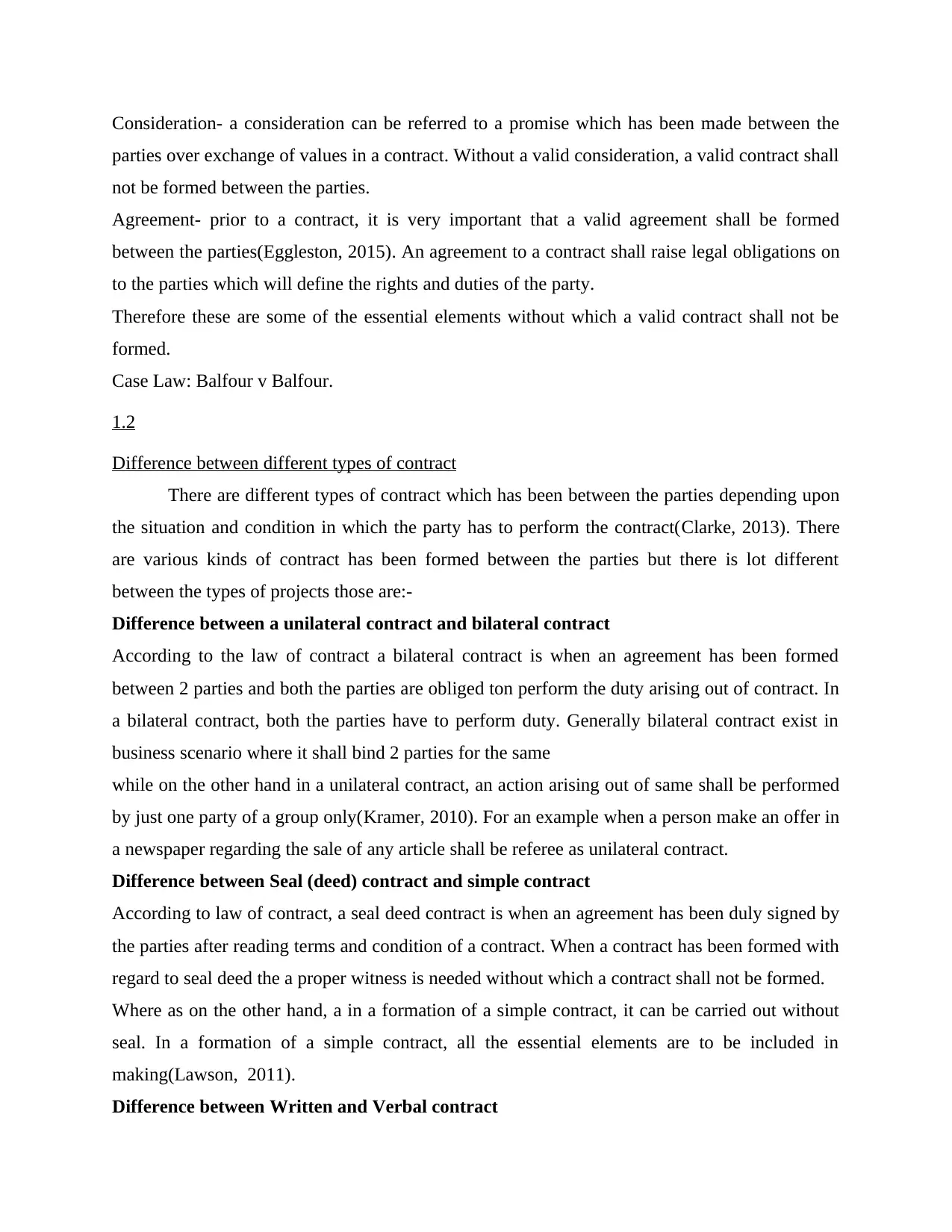
Consideration- a consideration can be referred to a promise which has been made between the
parties over exchange of values in a contract. Without a valid consideration, a valid contract shall
not be formed between the parties.
Agreement- prior to a contract, it is very important that a valid agreement shall be formed
between the parties(Eggleston, 2015). An agreement to a contract shall raise legal obligations on
to the parties which will define the rights and duties of the party.
Therefore these are some of the essential elements without which a valid contract shall not be
formed.
Case Law: Balfour v Balfour.
1.2
Difference between different types of contract
There are different types of contract which has been between the parties depending upon
the situation and condition in which the party has to perform the contract(Clarke, 2013). There
are various kinds of contract has been formed between the parties but there is lot different
between the types of projects those are:-
Difference between a unilateral contract and bilateral contract
According to the law of contract a bilateral contract is when an agreement has been formed
between 2 parties and both the parties are obliged ton perform the duty arising out of contract. In
a bilateral contract, both the parties have to perform duty. Generally bilateral contract exist in
business scenario where it shall bind 2 parties for the same
while on the other hand in a unilateral contract, an action arising out of same shall be performed
by just one party of a group only(Kramer, 2010). For an example when a person make an offer in
a newspaper regarding the sale of any article shall be referee as unilateral contract.
Difference between Seal (deed) contract and simple contract
According to law of contract, a seal deed contract is when an agreement has been duly signed by
the parties after reading terms and condition of a contract. When a contract has been formed with
regard to seal deed the a proper witness is needed without which a contract shall not be formed.
Where as on the other hand, a in a formation of a simple contract, it can be carried out without
seal. In a formation of a simple contract, all the essential elements are to be included in
making(Lawson, 2011).
Difference between Written and Verbal contract
parties over exchange of values in a contract. Without a valid consideration, a valid contract shall
not be formed between the parties.
Agreement- prior to a contract, it is very important that a valid agreement shall be formed
between the parties(Eggleston, 2015). An agreement to a contract shall raise legal obligations on
to the parties which will define the rights and duties of the party.
Therefore these are some of the essential elements without which a valid contract shall not be
formed.
Case Law: Balfour v Balfour.
1.2
Difference between different types of contract
There are different types of contract which has been between the parties depending upon
the situation and condition in which the party has to perform the contract(Clarke, 2013). There
are various kinds of contract has been formed between the parties but there is lot different
between the types of projects those are:-
Difference between a unilateral contract and bilateral contract
According to the law of contract a bilateral contract is when an agreement has been formed
between 2 parties and both the parties are obliged ton perform the duty arising out of contract. In
a bilateral contract, both the parties have to perform duty. Generally bilateral contract exist in
business scenario where it shall bind 2 parties for the same
while on the other hand in a unilateral contract, an action arising out of same shall be performed
by just one party of a group only(Kramer, 2010). For an example when a person make an offer in
a newspaper regarding the sale of any article shall be referee as unilateral contract.
Difference between Seal (deed) contract and simple contract
According to law of contract, a seal deed contract is when an agreement has been duly signed by
the parties after reading terms and condition of a contract. When a contract has been formed with
regard to seal deed the a proper witness is needed without which a contract shall not be formed.
Where as on the other hand, a in a formation of a simple contract, it can be carried out without
seal. In a formation of a simple contract, all the essential elements are to be included in
making(Lawson, 2011).
Difference between Written and Verbal contract
Paraphrase This Document
Need a fresh take? Get an instant paraphrase of this document with our AI Paraphraser
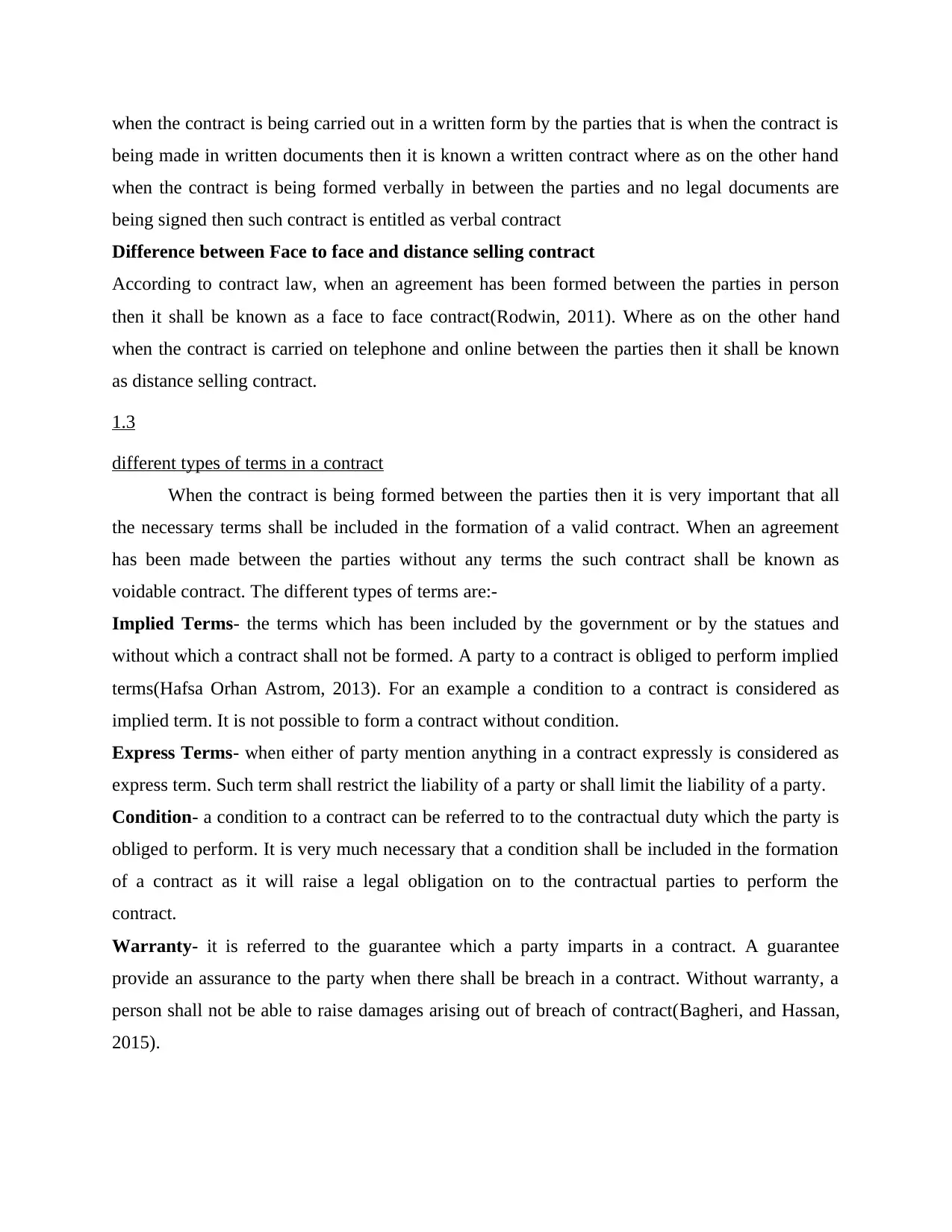
when the contract is being carried out in a written form by the parties that is when the contract is
being made in written documents then it is known a written contract where as on the other hand
when the contract is being formed verbally in between the parties and no legal documents are
being signed then such contract is entitled as verbal contract
Difference between Face to face and distance selling contract
According to contract law, when an agreement has been formed between the parties in person
then it shall be known as a face to face contract(Rodwin, 2011). Where as on the other hand
when the contract is carried on telephone and online between the parties then it shall be known
as distance selling contract.
1.3
different types of terms in a contract
When the contract is being formed between the parties then it is very important that all
the necessary terms shall be included in the formation of a valid contract. When an agreement
has been made between the parties without any terms the such contract shall be known as
voidable contract. The different types of terms are:-
Implied Terms- the terms which has been included by the government or by the statues and
without which a contract shall not be formed. A party to a contract is obliged to perform implied
terms(Hafsa Orhan Astrom, 2013). For an example a condition to a contract is considered as
implied term. It is not possible to form a contract without condition.
Express Terms- when either of party mention anything in a contract expressly is considered as
express term. Such term shall restrict the liability of a party or shall limit the liability of a party.
Condition- a condition to a contract can be referred to to the contractual duty which the party is
obliged to perform. It is very much necessary that a condition shall be included in the formation
of a contract as it will raise a legal obligation on to the contractual parties to perform the
contract.
Warranty- it is referred to the guarantee which a party imparts in a contract. A guarantee
provide an assurance to the party when there shall be breach in a contract. Without warranty, a
person shall not be able to raise damages arising out of breach of contract(Bagheri, and Hassan,
2015).
being made in written documents then it is known a written contract where as on the other hand
when the contract is being formed verbally in between the parties and no legal documents are
being signed then such contract is entitled as verbal contract
Difference between Face to face and distance selling contract
According to contract law, when an agreement has been formed between the parties in person
then it shall be known as a face to face contract(Rodwin, 2011). Where as on the other hand
when the contract is carried on telephone and online between the parties then it shall be known
as distance selling contract.
1.3
different types of terms in a contract
When the contract is being formed between the parties then it is very important that all
the necessary terms shall be included in the formation of a valid contract. When an agreement
has been made between the parties without any terms the such contract shall be known as
voidable contract. The different types of terms are:-
Implied Terms- the terms which has been included by the government or by the statues and
without which a contract shall not be formed. A party to a contract is obliged to perform implied
terms(Hafsa Orhan Astrom, 2013). For an example a condition to a contract is considered as
implied term. It is not possible to form a contract without condition.
Express Terms- when either of party mention anything in a contract expressly is considered as
express term. Such term shall restrict the liability of a party or shall limit the liability of a party.
Condition- a condition to a contract can be referred to to the contractual duty which the party is
obliged to perform. It is very much necessary that a condition shall be included in the formation
of a contract as it will raise a legal obligation on to the contractual parties to perform the
contract.
Warranty- it is referred to the guarantee which a party imparts in a contract. A guarantee
provide an assurance to the party when there shall be breach in a contract. Without warranty, a
person shall not be able to raise damages arising out of breach of contract(Bagheri, and Hassan,
2015).
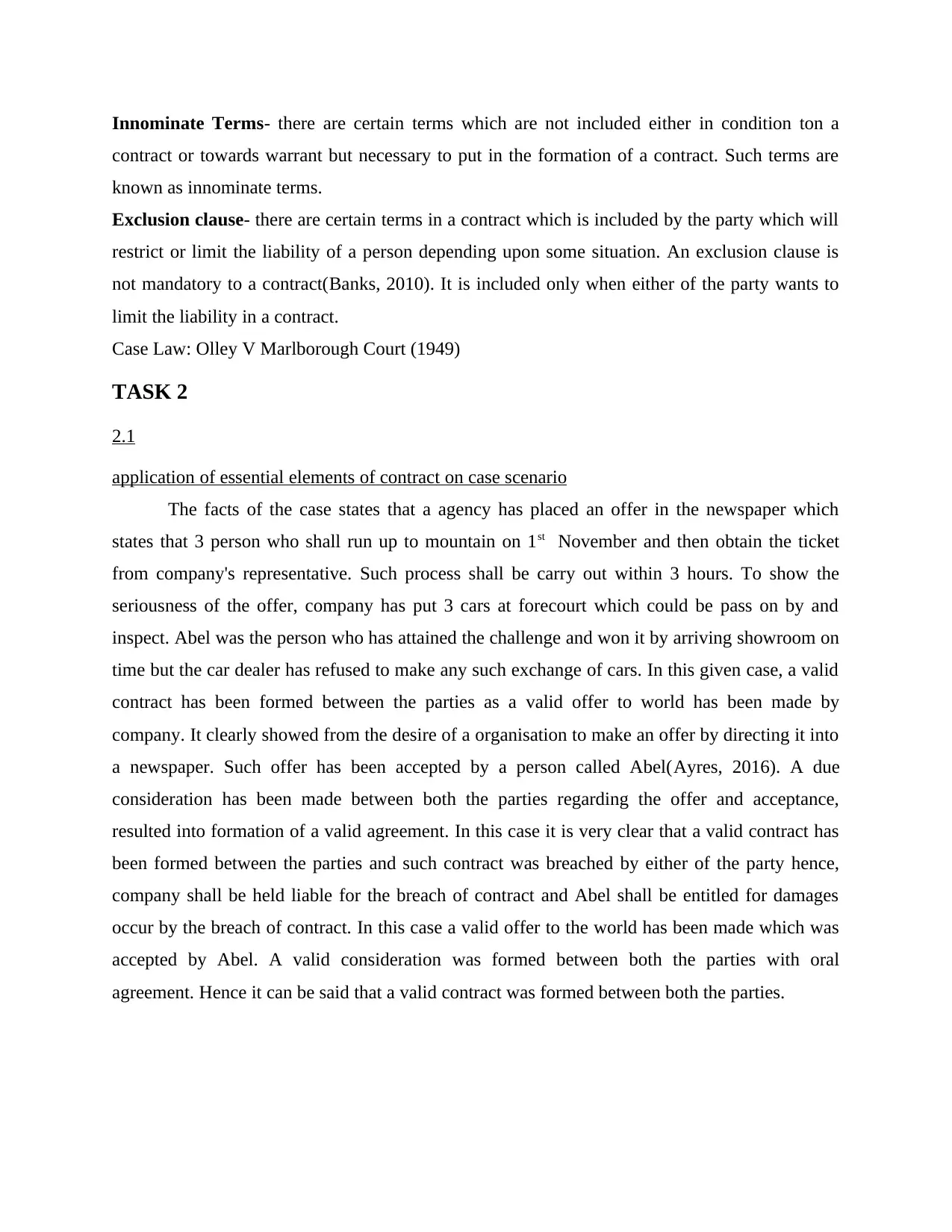
Innominate Terms- there are certain terms which are not included either in condition ton a
contract or towards warrant but necessary to put in the formation of a contract. Such terms are
known as innominate terms.
Exclusion clause- there are certain terms in a contract which is included by the party which will
restrict or limit the liability of a person depending upon some situation. An exclusion clause is
not mandatory to a contract(Banks, 2010). It is included only when either of the party wants to
limit the liability in a contract.
Case Law: Olley V Marlborough Court (1949)
TASK 2
2.1
application of essential elements of contract on case scenario
The facts of the case states that a agency has placed an offer in the newspaper which
states that 3 person who shall run up to mountain on 1st November and then obtain the ticket
from company's representative. Such process shall be carry out within 3 hours. To show the
seriousness of the offer, company has put 3 cars at forecourt which could be pass on by and
inspect. Abel was the person who has attained the challenge and won it by arriving showroom on
time but the car dealer has refused to make any such exchange of cars. In this given case, a valid
contract has been formed between the parties as a valid offer to world has been made by
company. It clearly showed from the desire of a organisation to make an offer by directing it into
a newspaper. Such offer has been accepted by a person called Abel(Ayres, 2016). A due
consideration has been made between both the parties regarding the offer and acceptance,
resulted into formation of a valid agreement. In this case it is very clear that a valid contract has
been formed between the parties and such contract was breached by either of the party hence,
company shall be held liable for the breach of contract and Abel shall be entitled for damages
occur by the breach of contract. In this case a valid offer to the world has been made which was
accepted by Abel. A valid consideration was formed between both the parties with oral
agreement. Hence it can be said that a valid contract was formed between both the parties.
contract or towards warrant but necessary to put in the formation of a contract. Such terms are
known as innominate terms.
Exclusion clause- there are certain terms in a contract which is included by the party which will
restrict or limit the liability of a person depending upon some situation. An exclusion clause is
not mandatory to a contract(Banks, 2010). It is included only when either of the party wants to
limit the liability in a contract.
Case Law: Olley V Marlborough Court (1949)
TASK 2
2.1
application of essential elements of contract on case scenario
The facts of the case states that a agency has placed an offer in the newspaper which
states that 3 person who shall run up to mountain on 1st November and then obtain the ticket
from company's representative. Such process shall be carry out within 3 hours. To show the
seriousness of the offer, company has put 3 cars at forecourt which could be pass on by and
inspect. Abel was the person who has attained the challenge and won it by arriving showroom on
time but the car dealer has refused to make any such exchange of cars. In this given case, a valid
contract has been formed between the parties as a valid offer to world has been made by
company. It clearly showed from the desire of a organisation to make an offer by directing it into
a newspaper. Such offer has been accepted by a person called Abel(Ayres, 2016). A due
consideration has been made between both the parties regarding the offer and acceptance,
resulted into formation of a valid agreement. In this case it is very clear that a valid contract has
been formed between the parties and such contract was breached by either of the party hence,
company shall be held liable for the breach of contract and Abel shall be entitled for damages
occur by the breach of contract. In this case a valid offer to the world has been made which was
accepted by Abel. A valid consideration was formed between both the parties with oral
agreement. Hence it can be said that a valid contract was formed between both the parties.
⊘ This is a preview!⊘
Do you want full access?
Subscribe today to unlock all pages.

Trusted by 1+ million students worldwide
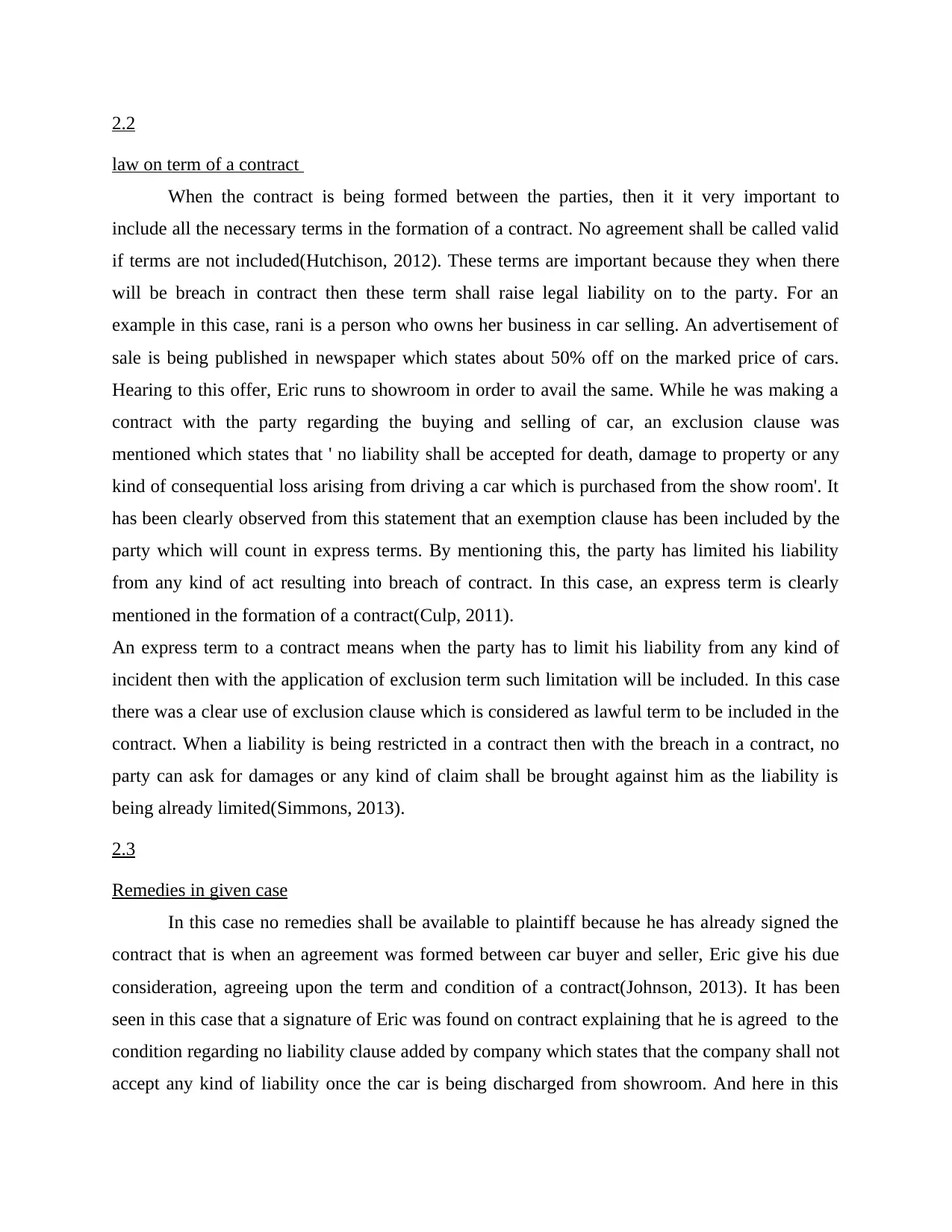
2.2
law on term of a contract
When the contract is being formed between the parties, then it it very important to
include all the necessary terms in the formation of a contract. No agreement shall be called valid
if terms are not included(Hutchison, 2012). These terms are important because they when there
will be breach in contract then these term shall raise legal liability on to the party. For an
example in this case, rani is a person who owns her business in car selling. An advertisement of
sale is being published in newspaper which states about 50% off on the marked price of cars.
Hearing to this offer, Eric runs to showroom in order to avail the same. While he was making a
contract with the party regarding the buying and selling of car, an exclusion clause was
mentioned which states that ' no liability shall be accepted for death, damage to property or any
kind of consequential loss arising from driving a car which is purchased from the show room'. It
has been clearly observed from this statement that an exemption clause has been included by the
party which will count in express terms. By mentioning this, the party has limited his liability
from any kind of act resulting into breach of contract. In this case, an express term is clearly
mentioned in the formation of a contract(Culp, 2011).
An express term to a contract means when the party has to limit his liability from any kind of
incident then with the application of exclusion term such limitation will be included. In this case
there was a clear use of exclusion clause which is considered as lawful term to be included in the
contract. When a liability is being restricted in a contract then with the breach in a contract, no
party can ask for damages or any kind of claim shall be brought against him as the liability is
being already limited(Simmons, 2013).
2.3
Remedies in given case
In this case no remedies shall be available to plaintiff because he has already signed the
contract that is when an agreement was formed between car buyer and seller, Eric give his due
consideration, agreeing upon the term and condition of a contract(Johnson, 2013). It has been
seen in this case that a signature of Eric was found on contract explaining that he is agreed to the
condition regarding no liability clause added by company which states that the company shall not
accept any kind of liability once the car is being discharged from showroom. And here in this
law on term of a contract
When the contract is being formed between the parties, then it it very important to
include all the necessary terms in the formation of a contract. No agreement shall be called valid
if terms are not included(Hutchison, 2012). These terms are important because they when there
will be breach in contract then these term shall raise legal liability on to the party. For an
example in this case, rani is a person who owns her business in car selling. An advertisement of
sale is being published in newspaper which states about 50% off on the marked price of cars.
Hearing to this offer, Eric runs to showroom in order to avail the same. While he was making a
contract with the party regarding the buying and selling of car, an exclusion clause was
mentioned which states that ' no liability shall be accepted for death, damage to property or any
kind of consequential loss arising from driving a car which is purchased from the show room'. It
has been clearly observed from this statement that an exemption clause has been included by the
party which will count in express terms. By mentioning this, the party has limited his liability
from any kind of act resulting into breach of contract. In this case, an express term is clearly
mentioned in the formation of a contract(Culp, 2011).
An express term to a contract means when the party has to limit his liability from any kind of
incident then with the application of exclusion term such limitation will be included. In this case
there was a clear use of exclusion clause which is considered as lawful term to be included in the
contract. When a liability is being restricted in a contract then with the breach in a contract, no
party can ask for damages or any kind of claim shall be brought against him as the liability is
being already limited(Simmons, 2013).
2.3
Remedies in given case
In this case no remedies shall be available to plaintiff because he has already signed the
contract that is when an agreement was formed between car buyer and seller, Eric give his due
consideration, agreeing upon the term and condition of a contract(Johnson, 2013). It has been
seen in this case that a signature of Eric was found on contract explaining that he is agreed to the
condition regarding no liability clause added by company which states that the company shall not
accept any kind of liability once the car is being discharged from showroom. And here in this
Paraphrase This Document
Need a fresh take? Get an instant paraphrase of this document with our AI Paraphraser
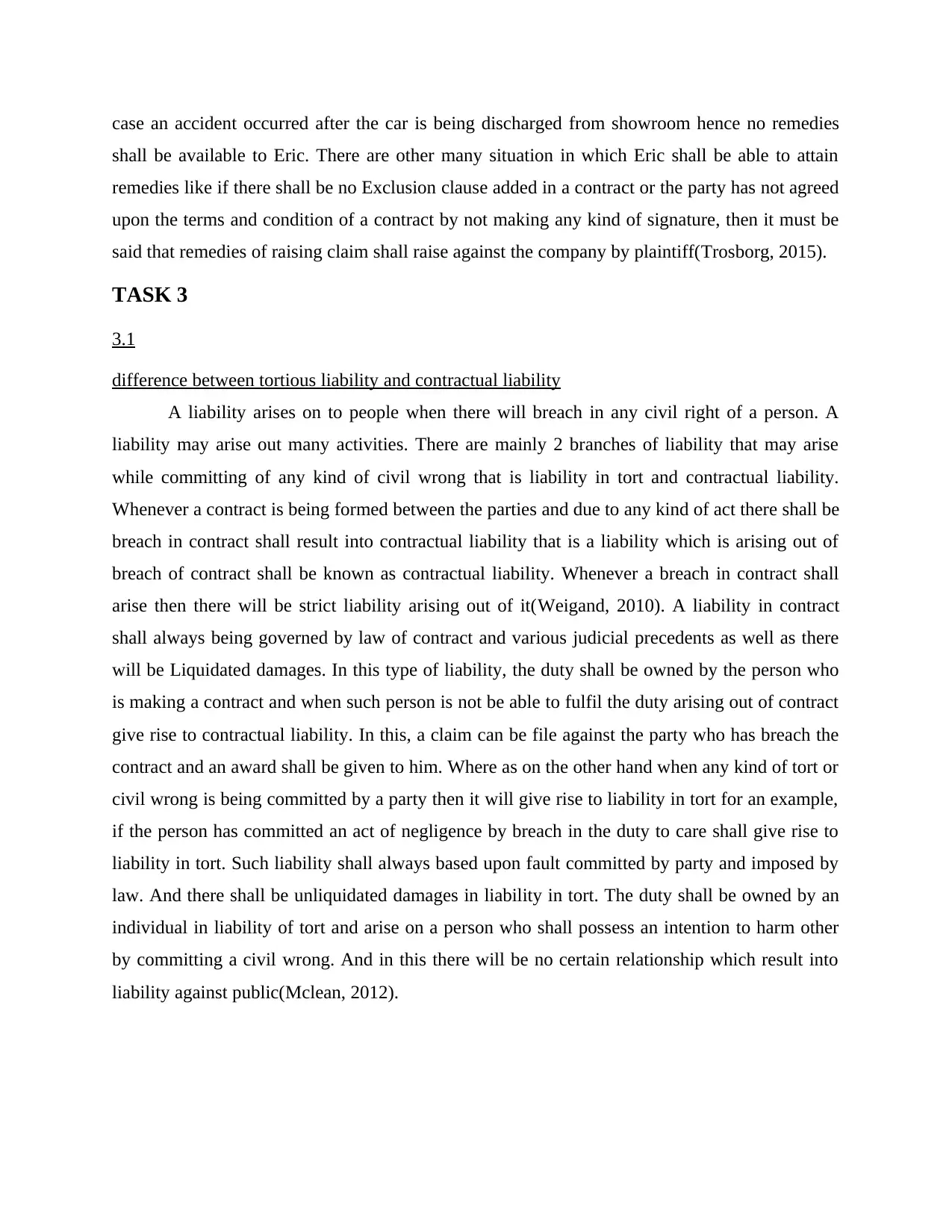
case an accident occurred after the car is being discharged from showroom hence no remedies
shall be available to Eric. There are other many situation in which Eric shall be able to attain
remedies like if there shall be no Exclusion clause added in a contract or the party has not agreed
upon the terms and condition of a contract by not making any kind of signature, then it must be
said that remedies of raising claim shall raise against the company by plaintiff(Trosborg, 2015).
TASK 3
3.1
difference between tortious liability and contractual liability
A liability arises on to people when there will breach in any civil right of a person. A
liability may arise out many activities. There are mainly 2 branches of liability that may arise
while committing of any kind of civil wrong that is liability in tort and contractual liability.
Whenever a contract is being formed between the parties and due to any kind of act there shall be
breach in contract shall result into contractual liability that is a liability which is arising out of
breach of contract shall be known as contractual liability. Whenever a breach in contract shall
arise then there will be strict liability arising out of it(Weigand, 2010). A liability in contract
shall always being governed by law of contract and various judicial precedents as well as there
will be Liquidated damages. In this type of liability, the duty shall be owned by the person who
is making a contract and when such person is not be able to fulfil the duty arising out of contract
give rise to contractual liability. In this, a claim can be file against the party who has breach the
contract and an award shall be given to him. Where as on the other hand when any kind of tort or
civil wrong is being committed by a party then it will give rise to liability in tort for an example,
if the person has committed an act of negligence by breach in the duty to care shall give rise to
liability in tort. Such liability shall always based upon fault committed by party and imposed by
law. And there shall be unliquidated damages in liability in tort. The duty shall be owned by an
individual in liability of tort and arise on a person who shall possess an intention to harm other
by committing a civil wrong. And in this there will be no certain relationship which result into
liability against public(Mclean, 2012).
shall be available to Eric. There are other many situation in which Eric shall be able to attain
remedies like if there shall be no Exclusion clause added in a contract or the party has not agreed
upon the terms and condition of a contract by not making any kind of signature, then it must be
said that remedies of raising claim shall raise against the company by plaintiff(Trosborg, 2015).
TASK 3
3.1
difference between tortious liability and contractual liability
A liability arises on to people when there will breach in any civil right of a person. A
liability may arise out many activities. There are mainly 2 branches of liability that may arise
while committing of any kind of civil wrong that is liability in tort and contractual liability.
Whenever a contract is being formed between the parties and due to any kind of act there shall be
breach in contract shall result into contractual liability that is a liability which is arising out of
breach of contract shall be known as contractual liability. Whenever a breach in contract shall
arise then there will be strict liability arising out of it(Weigand, 2010). A liability in contract
shall always being governed by law of contract and various judicial precedents as well as there
will be Liquidated damages. In this type of liability, the duty shall be owned by the person who
is making a contract and when such person is not be able to fulfil the duty arising out of contract
give rise to contractual liability. In this, a claim can be file against the party who has breach the
contract and an award shall be given to him. Where as on the other hand when any kind of tort or
civil wrong is being committed by a party then it will give rise to liability in tort for an example,
if the person has committed an act of negligence by breach in the duty to care shall give rise to
liability in tort. Such liability shall always based upon fault committed by party and imposed by
law. And there shall be unliquidated damages in liability in tort. The duty shall be owned by an
individual in liability of tort and arise on a person who shall possess an intention to harm other
by committing a civil wrong. And in this there will be no certain relationship which result into
liability against public(Mclean, 2012).
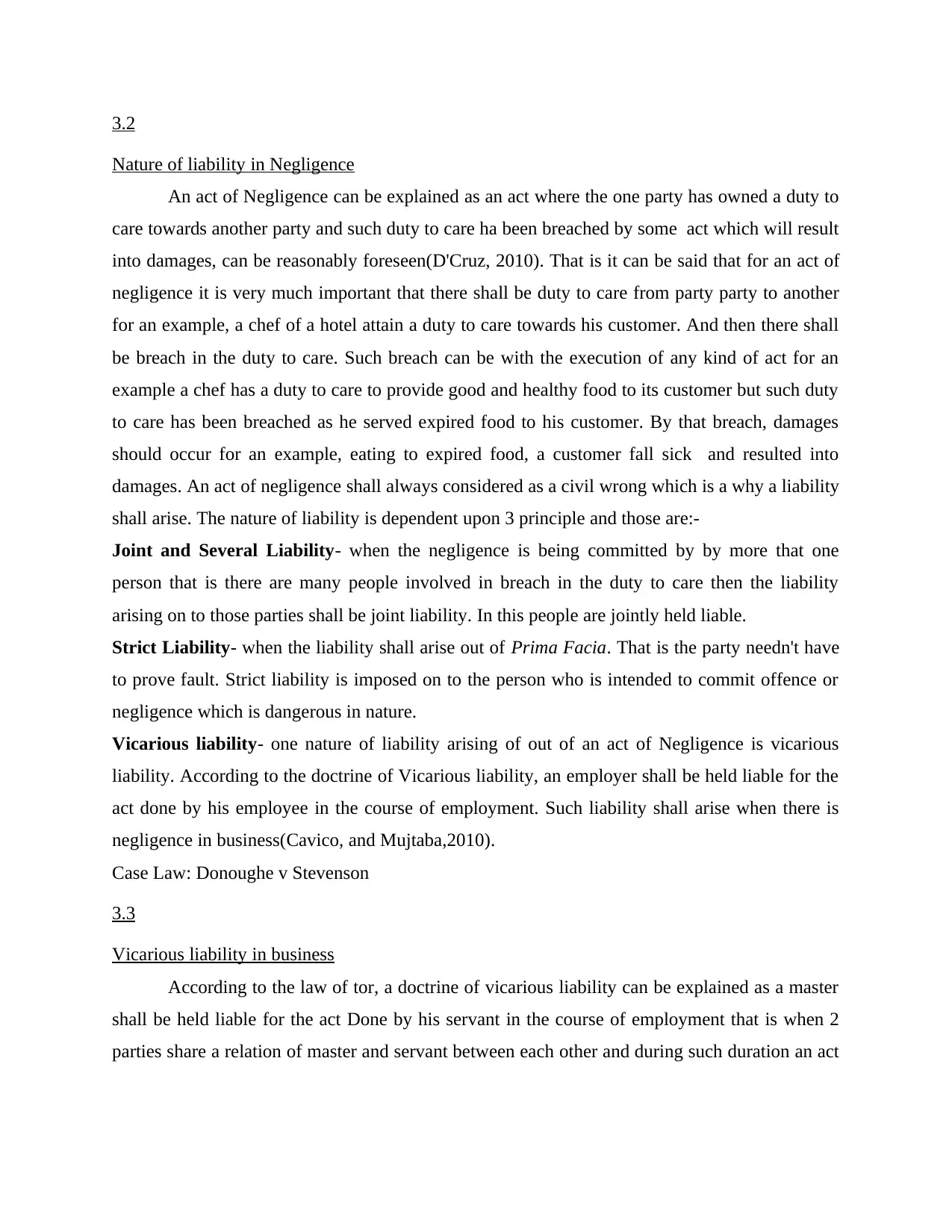
3.2
Nature of liability in Negligence
An act of Negligence can be explained as an act where the one party has owned a duty to
care towards another party and such duty to care ha been breached by some act which will result
into damages, can be reasonably foreseen(D'Cruz, 2010). That is it can be said that for an act of
negligence it is very much important that there shall be duty to care from party party to another
for an example, a chef of a hotel attain a duty to care towards his customer. And then there shall
be breach in the duty to care. Such breach can be with the execution of any kind of act for an
example a chef has a duty to care to provide good and healthy food to its customer but such duty
to care has been breached as he served expired food to his customer. By that breach, damages
should occur for an example, eating to expired food, a customer fall sick and resulted into
damages. An act of negligence shall always considered as a civil wrong which is a why a liability
shall arise. The nature of liability is dependent upon 3 principle and those are:-
Joint and Several Liability- when the negligence is being committed by by more that one
person that is there are many people involved in breach in the duty to care then the liability
arising on to those parties shall be joint liability. In this people are jointly held liable.
Strict Liability- when the liability shall arise out of Prima Facia. That is the party needn't have
to prove fault. Strict liability is imposed on to the person who is intended to commit offence or
negligence which is dangerous in nature.
Vicarious liability- one nature of liability arising of out of an act of Negligence is vicarious
liability. According to the doctrine of Vicarious liability, an employer shall be held liable for the
act done by his employee in the course of employment. Such liability shall arise when there is
negligence in business(Cavico, and Mujtaba,2010).
Case Law: Donoughe v Stevenson
3.3
Vicarious liability in business
According to the law of tor, a doctrine of vicarious liability can be explained as a master
shall be held liable for the act Done by his servant in the course of employment that is when 2
parties share a relation of master and servant between each other and during such duration an act
Nature of liability in Negligence
An act of Negligence can be explained as an act where the one party has owned a duty to
care towards another party and such duty to care ha been breached by some act which will result
into damages, can be reasonably foreseen(D'Cruz, 2010). That is it can be said that for an act of
negligence it is very much important that there shall be duty to care from party party to another
for an example, a chef of a hotel attain a duty to care towards his customer. And then there shall
be breach in the duty to care. Such breach can be with the execution of any kind of act for an
example a chef has a duty to care to provide good and healthy food to its customer but such duty
to care has been breached as he served expired food to his customer. By that breach, damages
should occur for an example, eating to expired food, a customer fall sick and resulted into
damages. An act of negligence shall always considered as a civil wrong which is a why a liability
shall arise. The nature of liability is dependent upon 3 principle and those are:-
Joint and Several Liability- when the negligence is being committed by by more that one
person that is there are many people involved in breach in the duty to care then the liability
arising on to those parties shall be joint liability. In this people are jointly held liable.
Strict Liability- when the liability shall arise out of Prima Facia. That is the party needn't have
to prove fault. Strict liability is imposed on to the person who is intended to commit offence or
negligence which is dangerous in nature.
Vicarious liability- one nature of liability arising of out of an act of Negligence is vicarious
liability. According to the doctrine of Vicarious liability, an employer shall be held liable for the
act done by his employee in the course of employment. Such liability shall arise when there is
negligence in business(Cavico, and Mujtaba,2010).
Case Law: Donoughe v Stevenson
3.3
Vicarious liability in business
According to the law of tor, a doctrine of vicarious liability can be explained as a master
shall be held liable for the act Done by his servant in the course of employment that is when 2
parties share a relation of master and servant between each other and during such duration an act
⊘ This is a preview!⊘
Do you want full access?
Subscribe today to unlock all pages.

Trusted by 1+ million students worldwide
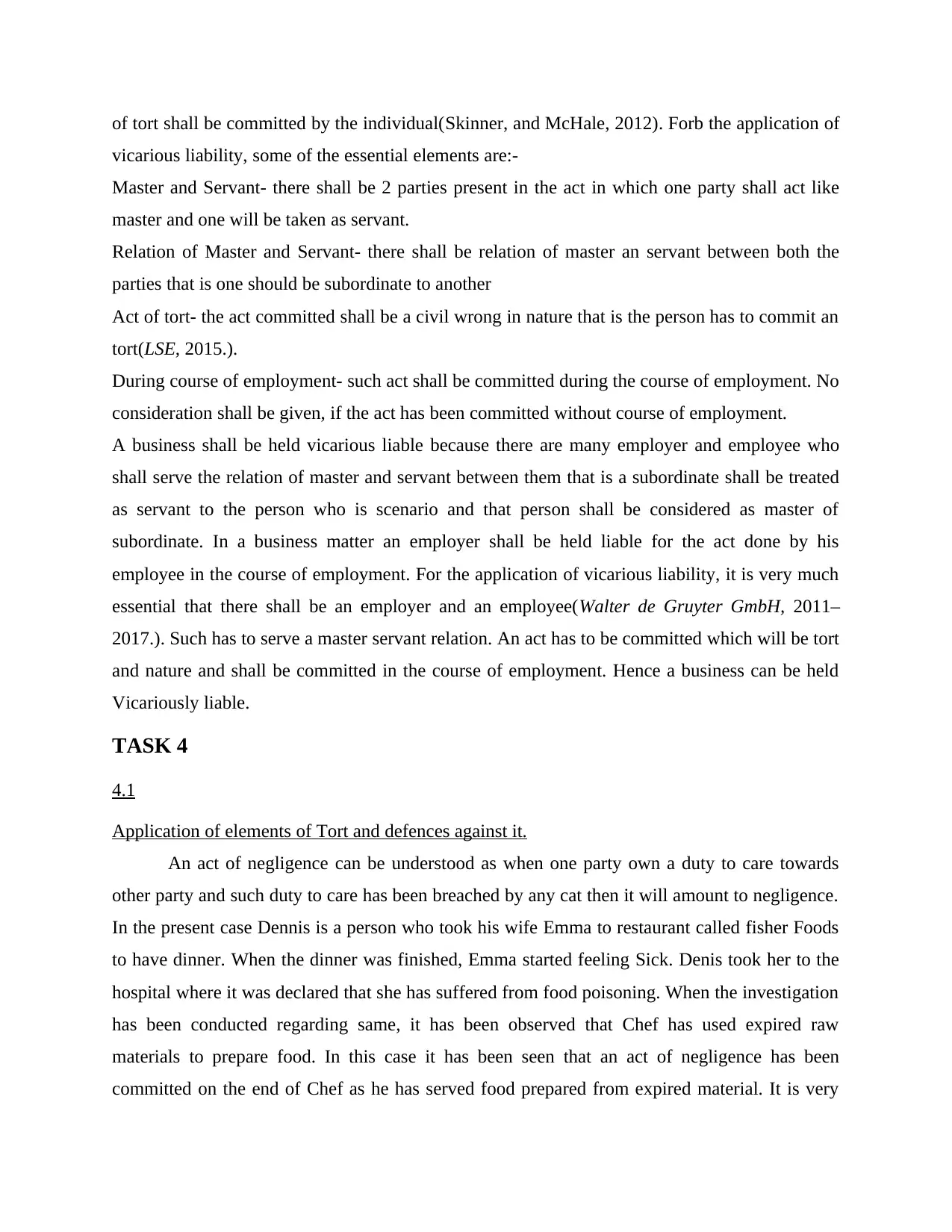
of tort shall be committed by the individual(Skinner, and McHale, 2012). Forb the application of
vicarious liability, some of the essential elements are:-
Master and Servant- there shall be 2 parties present in the act in which one party shall act like
master and one will be taken as servant.
Relation of Master and Servant- there shall be relation of master an servant between both the
parties that is one should be subordinate to another
Act of tort- the act committed shall be a civil wrong in nature that is the person has to commit an
tort(LSE, 2015.).
During course of employment- such act shall be committed during the course of employment. No
consideration shall be given, if the act has been committed without course of employment.
A business shall be held vicarious liable because there are many employer and employee who
shall serve the relation of master and servant between them that is a subordinate shall be treated
as servant to the person who is scenario and that person shall be considered as master of
subordinate. In a business matter an employer shall be held liable for the act done by his
employee in the course of employment. For the application of vicarious liability, it is very much
essential that there shall be an employer and an employee(Walter de Gruyter GmbH, 2011–
2017.). Such has to serve a master servant relation. An act has to be committed which will be tort
and nature and shall be committed in the course of employment. Hence a business can be held
Vicariously liable.
TASK 4
4.1
Application of elements of Tort and defences against it.
An act of negligence can be understood as when one party own a duty to care towards
other party and such duty to care has been breached by any cat then it will amount to negligence.
In the present case Dennis is a person who took his wife Emma to restaurant called fisher Foods
to have dinner. When the dinner was finished, Emma started feeling Sick. Denis took her to the
hospital where it was declared that she has suffered from food poisoning. When the investigation
has been conducted regarding same, it has been observed that Chef has used expired raw
materials to prepare food. In this case it has been seen that an act of negligence has been
committed on the end of Chef as he has served food prepared from expired material. It is very
vicarious liability, some of the essential elements are:-
Master and Servant- there shall be 2 parties present in the act in which one party shall act like
master and one will be taken as servant.
Relation of Master and Servant- there shall be relation of master an servant between both the
parties that is one should be subordinate to another
Act of tort- the act committed shall be a civil wrong in nature that is the person has to commit an
tort(LSE, 2015.).
During course of employment- such act shall be committed during the course of employment. No
consideration shall be given, if the act has been committed without course of employment.
A business shall be held vicarious liable because there are many employer and employee who
shall serve the relation of master and servant between them that is a subordinate shall be treated
as servant to the person who is scenario and that person shall be considered as master of
subordinate. In a business matter an employer shall be held liable for the act done by his
employee in the course of employment. For the application of vicarious liability, it is very much
essential that there shall be an employer and an employee(Walter de Gruyter GmbH, 2011–
2017.). Such has to serve a master servant relation. An act has to be committed which will be tort
and nature and shall be committed in the course of employment. Hence a business can be held
Vicariously liable.
TASK 4
4.1
Application of elements of Tort and defences against it.
An act of negligence can be understood as when one party own a duty to care towards
other party and such duty to care has been breached by any cat then it will amount to negligence.
In the present case Dennis is a person who took his wife Emma to restaurant called fisher Foods
to have dinner. When the dinner was finished, Emma started feeling Sick. Denis took her to the
hospital where it was declared that she has suffered from food poisoning. When the investigation
has been conducted regarding same, it has been observed that Chef has used expired raw
materials to prepare food. In this case it has been seen that an act of negligence has been
committed on the end of Chef as he has served food prepared from expired material. It is very
Paraphrase This Document
Need a fresh take? Get an instant paraphrase of this document with our AI Paraphraser
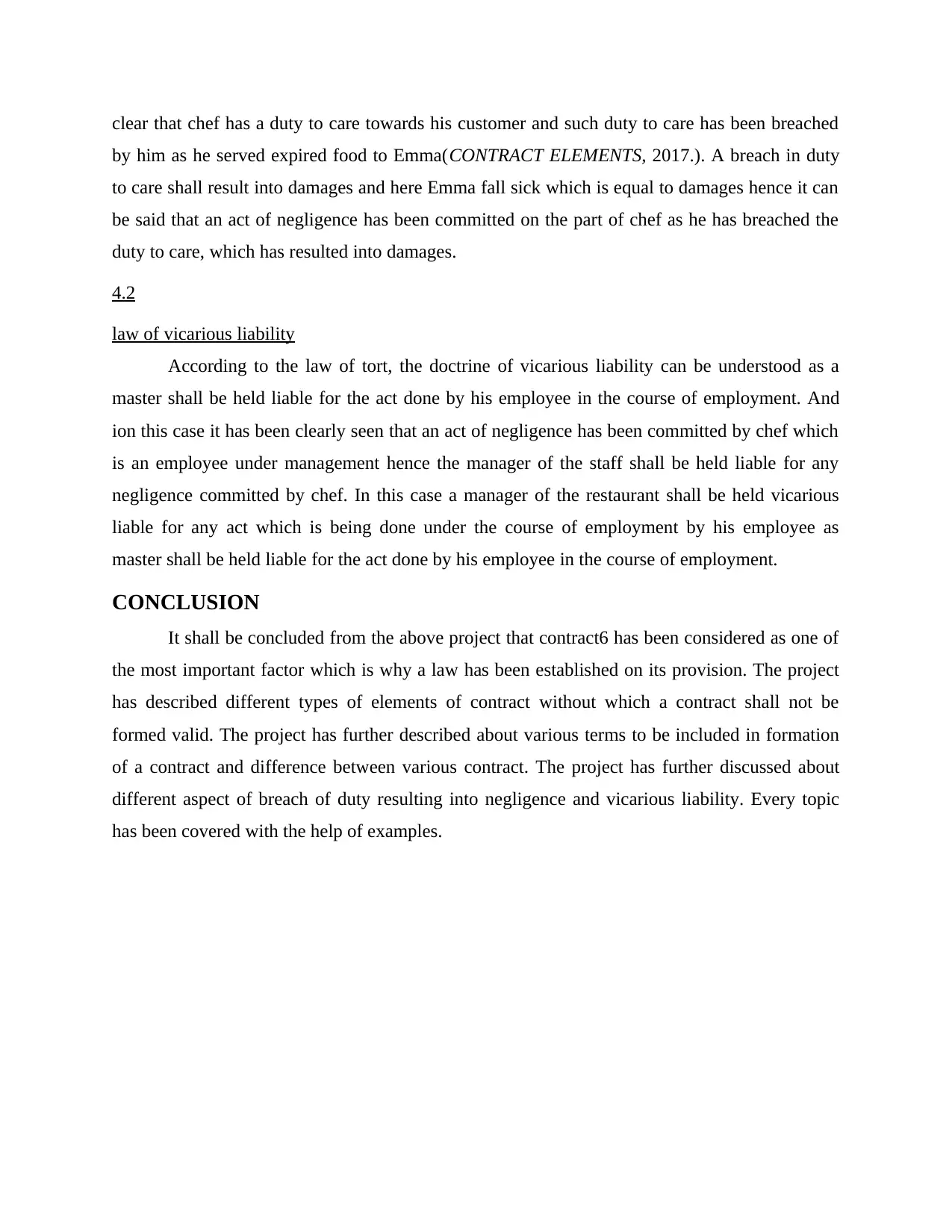
clear that chef has a duty to care towards his customer and such duty to care has been breached
by him as he served expired food to Emma(CONTRACT ELEMENTS, 2017.). A breach in duty
to care shall result into damages and here Emma fall sick which is equal to damages hence it can
be said that an act of negligence has been committed on the part of chef as he has breached the
duty to care, which has resulted into damages.
4.2
law of vicarious liability
According to the law of tort, the doctrine of vicarious liability can be understood as a
master shall be held liable for the act done by his employee in the course of employment. And
ion this case it has been clearly seen that an act of negligence has been committed by chef which
is an employee under management hence the manager of the staff shall be held liable for any
negligence committed by chef. In this case a manager of the restaurant shall be held vicarious
liable for any act which is being done under the course of employment by his employee as
master shall be held liable for the act done by his employee in the course of employment.
CONCLUSION
It shall be concluded from the above project that contract6 has been considered as one of
the most important factor which is why a law has been established on its provision. The project
has described different types of elements of contract without which a contract shall not be
formed valid. The project has further described about various terms to be included in formation
of a contract and difference between various contract. The project has further discussed about
different aspect of breach of duty resulting into negligence and vicarious liability. Every topic
has been covered with the help of examples.
by him as he served expired food to Emma(CONTRACT ELEMENTS, 2017.). A breach in duty
to care shall result into damages and here Emma fall sick which is equal to damages hence it can
be said that an act of negligence has been committed on the part of chef as he has breached the
duty to care, which has resulted into damages.
4.2
law of vicarious liability
According to the law of tort, the doctrine of vicarious liability can be understood as a
master shall be held liable for the act done by his employee in the course of employment. And
ion this case it has been clearly seen that an act of negligence has been committed by chef which
is an employee under management hence the manager of the staff shall be held liable for any
negligence committed by chef. In this case a manager of the restaurant shall be held vicarious
liable for any act which is being done under the course of employment by his employee as
master shall be held liable for the act done by his employee in the course of employment.
CONCLUSION
It shall be concluded from the above project that contract6 has been considered as one of
the most important factor which is why a law has been established on its provision. The project
has described different types of elements of contract without which a contract shall not be
formed valid. The project has further described about various terms to be included in formation
of a contract and difference between various contract. The project has further discussed about
different aspect of breach of duty resulting into negligence and vicarious liability. Every topic
has been covered with the help of examples.
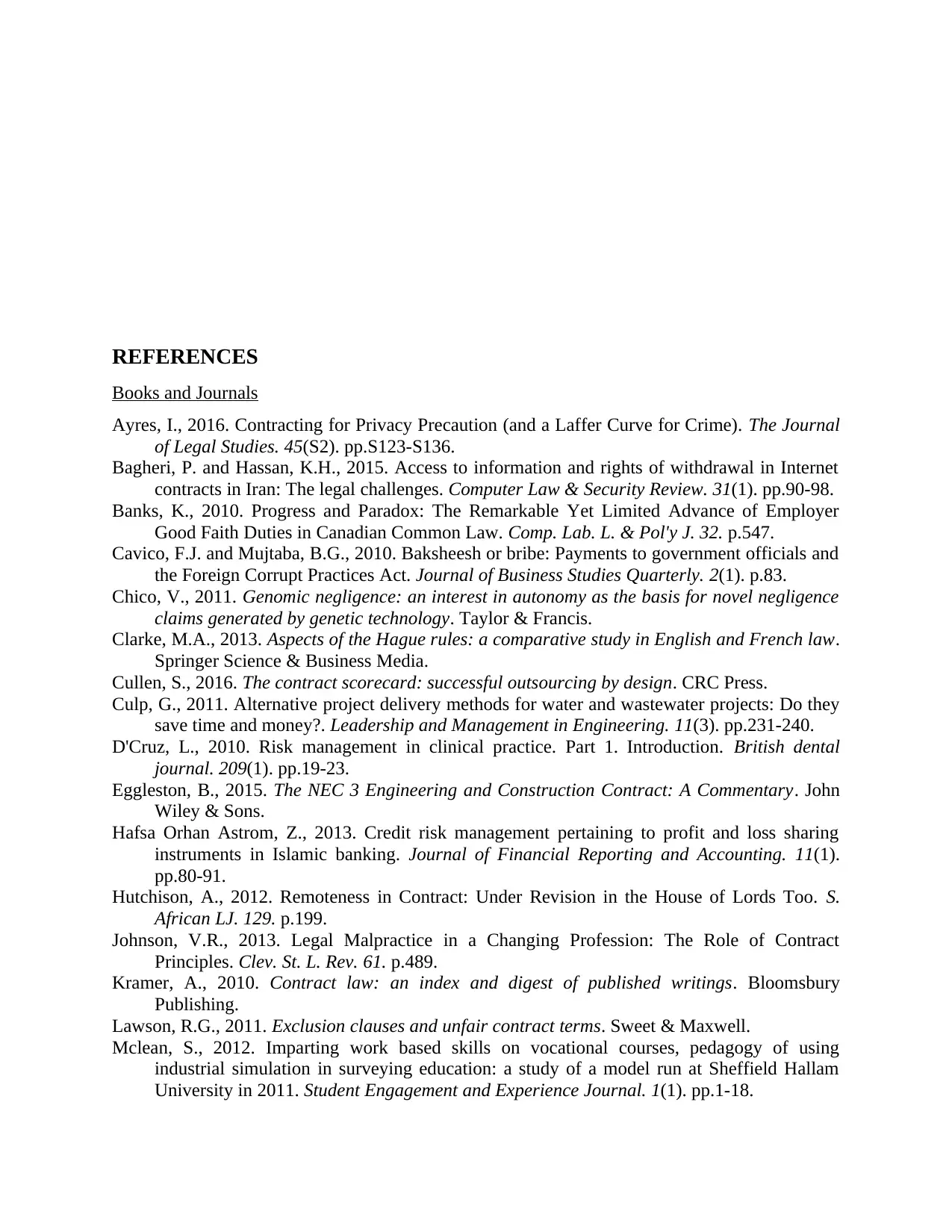
REFERENCES
Books and Journals
Ayres, I., 2016. Contracting for Privacy Precaution (and a Laffer Curve for Crime). The Journal
of Legal Studies. 45(S2). pp.S123-S136.
Bagheri, P. and Hassan, K.H., 2015. Access to information and rights of withdrawal in Internet
contracts in Iran: The legal challenges. Computer Law & Security Review. 31(1). pp.90-98.
Banks, K., 2010. Progress and Paradox: The Remarkable Yet Limited Advance of Employer
Good Faith Duties in Canadian Common Law. Comp. Lab. L. & Pol'y J. 32. p.547.
Cavico, F.J. and Mujtaba, B.G., 2010. Baksheesh or bribe: Payments to government officials and
the Foreign Corrupt Practices Act. Journal of Business Studies Quarterly. 2(1). p.83.
Chico, V., 2011. Genomic negligence: an interest in autonomy as the basis for novel negligence
claims generated by genetic technology. Taylor & Francis.
Clarke, M.A., 2013. Aspects of the Hague rules: a comparative study in English and French law.
Springer Science & Business Media.
Cullen, S., 2016. The contract scorecard: successful outsourcing by design. CRC Press.
Culp, G., 2011. Alternative project delivery methods for water and wastewater projects: Do they
save time and money?. Leadership and Management in Engineering. 11(3). pp.231-240.
D'Cruz, L., 2010. Risk management in clinical practice. Part 1. Introduction. British dental
journal. 209(1). pp.19-23.
Eggleston, B., 2015. The NEC 3 Engineering and Construction Contract: A Commentary. John
Wiley & Sons.
Hafsa Orhan Astrom, Z., 2013. Credit risk management pertaining to profit and loss sharing
instruments in Islamic banking. Journal of Financial Reporting and Accounting. 11(1).
pp.80-91.
Hutchison, A., 2012. Remoteness in Contract: Under Revision in the House of Lords Too. S.
African LJ. 129. p.199.
Johnson, V.R., 2013. Legal Malpractice in a Changing Profession: The Role of Contract
Principles. Clev. St. L. Rev. 61. p.489.
Kramer, A., 2010. Contract law: an index and digest of published writings. Bloomsbury
Publishing.
Lawson, R.G., 2011. Exclusion clauses and unfair contract terms. Sweet & Maxwell.
Mclean, S., 2012. Imparting work based skills on vocational courses, pedagogy of using
industrial simulation in surveying education: a study of a model run at Sheffield Hallam
University in 2011. Student Engagement and Experience Journal. 1(1). pp.1-18.
Books and Journals
Ayres, I., 2016. Contracting for Privacy Precaution (and a Laffer Curve for Crime). The Journal
of Legal Studies. 45(S2). pp.S123-S136.
Bagheri, P. and Hassan, K.H., 2015. Access to information and rights of withdrawal in Internet
contracts in Iran: The legal challenges. Computer Law & Security Review. 31(1). pp.90-98.
Banks, K., 2010. Progress and Paradox: The Remarkable Yet Limited Advance of Employer
Good Faith Duties in Canadian Common Law. Comp. Lab. L. & Pol'y J. 32. p.547.
Cavico, F.J. and Mujtaba, B.G., 2010. Baksheesh or bribe: Payments to government officials and
the Foreign Corrupt Practices Act. Journal of Business Studies Quarterly. 2(1). p.83.
Chico, V., 2011. Genomic negligence: an interest in autonomy as the basis for novel negligence
claims generated by genetic technology. Taylor & Francis.
Clarke, M.A., 2013. Aspects of the Hague rules: a comparative study in English and French law.
Springer Science & Business Media.
Cullen, S., 2016. The contract scorecard: successful outsourcing by design. CRC Press.
Culp, G., 2011. Alternative project delivery methods for water and wastewater projects: Do they
save time and money?. Leadership and Management in Engineering. 11(3). pp.231-240.
D'Cruz, L., 2010. Risk management in clinical practice. Part 1. Introduction. British dental
journal. 209(1). pp.19-23.
Eggleston, B., 2015. The NEC 3 Engineering and Construction Contract: A Commentary. John
Wiley & Sons.
Hafsa Orhan Astrom, Z., 2013. Credit risk management pertaining to profit and loss sharing
instruments in Islamic banking. Journal of Financial Reporting and Accounting. 11(1).
pp.80-91.
Hutchison, A., 2012. Remoteness in Contract: Under Revision in the House of Lords Too. S.
African LJ. 129. p.199.
Johnson, V.R., 2013. Legal Malpractice in a Changing Profession: The Role of Contract
Principles. Clev. St. L. Rev. 61. p.489.
Kramer, A., 2010. Contract law: an index and digest of published writings. Bloomsbury
Publishing.
Lawson, R.G., 2011. Exclusion clauses and unfair contract terms. Sweet & Maxwell.
Mclean, S., 2012. Imparting work based skills on vocational courses, pedagogy of using
industrial simulation in surveying education: a study of a model run at Sheffield Hallam
University in 2011. Student Engagement and Experience Journal. 1(1). pp.1-18.
⊘ This is a preview!⊘
Do you want full access?
Subscribe today to unlock all pages.

Trusted by 1+ million students worldwide
1 out of 14
Related Documents
Your All-in-One AI-Powered Toolkit for Academic Success.
+13062052269
info@desklib.com
Available 24*7 on WhatsApp / Email
![[object Object]](/_next/static/media/star-bottom.7253800d.svg)
Unlock your academic potential
Copyright © 2020–2025 A2Z Services. All Rights Reserved. Developed and managed by ZUCOL.





